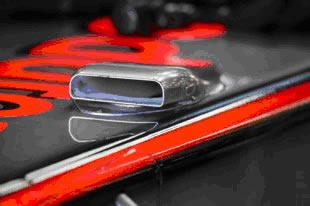Engine Air Intake - Airbox, Scoop
Sucking warm air in from the engine bay is a great way to lose power. Getting enough fresh, cold air into the cylinders is a challenge on normally aspirated cars, but even harder on forced air vehicles that use a turbocharger or a supercharger, since these devices raise the air temperature as they raise the air pressure. Consequently you often see intercoolers (sometimes called aftercoolers) and big scoops. Make sure you have a cold air feed pipe to get cool air from outside of the engine bay - cold air carries more oxygen.
Motorcyclists and car enthusiasts use the term airbox for what might more properly be described as an air intake chamber.
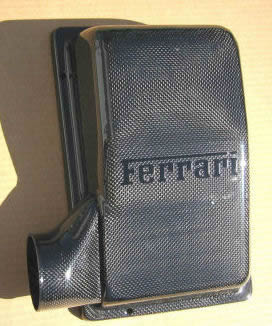 |
|
Older engines drew air directly from the surroundings into each individual carburator. Modern engines instead draw air into an airbox (an air intake chamber), which is connected by individual hoses to each carburator, or directly to the intake ports in fuel-injected engines. This allows the use of one air filter instead of many, and allows the designers to exploit the properties of air to improve performance.
The standard mods include a Cold Air Intake box, which replaces the stock air filter box and panel filter with an airbox that seals against the bonnet, or has a sealed top, and opens to the rear cowl to get air from the cowl opening in front of the windshield for example.
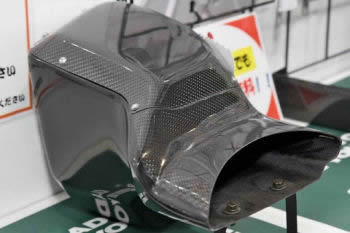
Airboxes do slow the air down. That converts the kinetic energy of the air into static pressure. A good airbox is shaped like a diffuser 'bent' round a corner. A bad one isn't... If you assume incompressibility so Bernoulli's equation is valid, you can easily calculate the effect. Refreshing myself on my old college physics text, I can now understand that Bernoulli's equation tells us that the pressure increases because the air slows down.
Ram-air intake is any intake design which uses the dynamic air pressure created by vehicle motion to increase the static air pressure inside of the intake manifold on an engine, thus allowing a greater mass flow through the cylinder intake valve and hence increasing engine power.
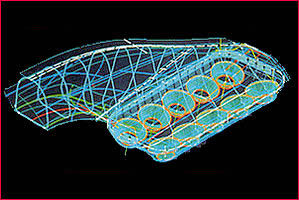 Before 2014 naturally aspirated Formula 1 racing engines have tuned intake systems and can now achieve volumetric efficiencies in excess of 175% and peak engine speeds in excess of 18,000 rev/min.
Before 2014 naturally aspirated Formula 1 racing engines have tuned intake systems and can now achieve volumetric efficiencies in excess of 175% and peak engine speeds in excess of 18,000 rev/min.
Engines designed for single seater racing commonly dispense with the intake manifold and its convoluted and restricting flow path preferring single lengths of pipe feeding each cylinder separately from only one chamber.
An investigation into the intake process on a single cylinder racing engine has shown that inertial ram effects make a strong contribution to the intake process at high engine speeds whereas acoustic resonance effects are more important to the rather weak wave action that occurs at low engine speeds. An acoustic model of the resonant wave action has proved useful in distinguishing between these two effects.
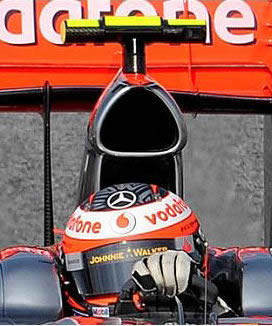 |
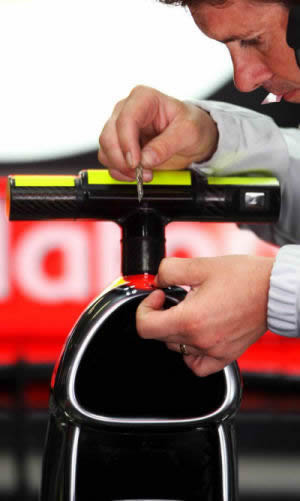 |
|---|---|
 |
|
Sir Isaac Newton created three "law's of motion".
More commonly known as the "law of inertia", the first law of motion says:
"An object at rest tends to stay at rest"
and
"An object in motion tends to stay in motion".
This law is the foundation for Ram Induction.
Visualize the intake cycle of the engine as air flowing through the intake manifold runner, past the intake valve, and into the cylinder. Everything is fine until the intake valve shuts.
Here is where the law of inertia comes to play - because the air was in motion, it wants to stay in motion. But the air can't go anywhere because the valve is shut so it piles up against the valve like a chain accident on the freeway. With one piece of air piling up on the next piece of air on the next on the next, the air becomes compressed. This compressed air has to go somewhere so it turns around and flows back through the intake manifold runner in the form of a pressure wave.
This pressure wave bounces back and forth in the runner and if it arrives back at the intake valve when the valve opens (proper arrival time), it is drawn into the engine. This bouncing pressure wave of air and the proper arrival time at the intake valve creates a form of supercharging.
In order to create this supercharging, all of the variables have to be aligned perfectly so the pressure wave arrives at the intake valve at the right time. This combination of synchronized events is known as 'resonant conditions'.
The following parameters affect the arrival of our pressure wave at the intake valve:
- Engine speed
- The number of crank rotation degrees the intake valve is closed.
- Length of the intake runner tube.
If these parameters are not balanced properly, ram induction doesn't work.
RAM Induction didn't die with the letter cars. In fact, RAM induction is so common today that almost every new engine design incorporates the concept. When you look at those snake-like intake manifolds in the new 300M, Ferraris or the V-10 Viper, you are looking at ram induction.
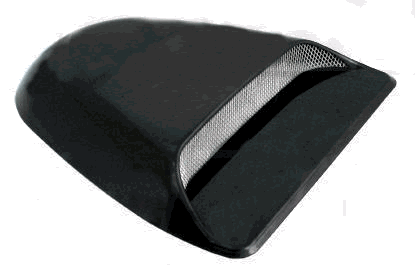
Normally, but not always, RAM air intake going together with air scoop. A bonnet or roof scoop is an upraised component on the hood or roof of a car that allows a flow of air to directly enter the engine compartment. It has one opening only and is closed on all other sides. Its main function is to allow a direct flow of air to the engine, hence the need for it to be upraised so as to effectively channel air to the engine compartment. It may be closed, and thus purely decorative, or serve to enhance performance in several possible ways.
At higher road speeds, a properly designed hood scoop can increase the speed and pressure with which air enters the engine's intake, creating a resonance supercharging effect. Such effects are typically only felt at very high speeds, making RAM air primarily useful for racing, not street performance.
Pontiac used the trade name Ram Air to describe its engines equipped with functional scoops. Despite the name, most of these systems only provided cool air, with little or no supercharging effect.
The RAM air intake works by reducing the intake air velocity by increasing the cross sectional area of the intake ducting. When air velocity goes down the dynamic pressure is reduced while the static pressure is increased. The increased static pressure in the plenum chamber has a positive effect on engine power, both because of the pressure itself and the increased air density this higher pressure gives.
Ram-air systems are used on high performance vehicles, most often on motorcycles and race cars. Ram-air has been a feature on some cars since the late sixties, but fell out of favor in the seventies, and has only recently made a comeback.
At low speeds increases in static pressure are however limited to a few percent. Given that the air velocity is reduced to zero without losses the pressure increase can be calculated according. The lack of losses also means without heating the air. Thus a ram-air intake also is a cold air intake.
It should be noted that in some cars the intake is placed behind the radiator, where not only the air is hot, but the pressure is below ambient pressure.
Modern parachutes use a ram-air system to pressurize a series of cells to provide the aerofoil shape.
To be effective, a functional scoop must be located at a high-pressure area on the hood or roof. For that reason, some functional scoops are located at the rear of the hood, near the car's cowl, where the curvature of the windshield creates such a high-pressure zone, and may be placed so that their opening faces the windshield (a reversed scoop).
The scoop will be most effective if it is either mounted high enough to clear the boundary layer (the slow-moving air that clings to the surface of a moving object) or if it is a "NACA duct," mounted below the surface and designed to draw the faster moving air outside of the boundary layer into the duct. A shallow scoop that is not a NACA duct may not suck a useful amount of air even if it is fitted with big opening.
Under the hood, an effective scoop must funnel air into the engine's intake in as short and direct path as possible, preferably through a tub or channel that is insulated against under hood heat.
 |
Nicely done bonnet scoop mounted high enough to clear the boundary layer (the slow-moving air that clings to the surface of a moving object) on the Dodge Challenger |
|

Scoop on the roof of the race ready Porsche GT9 |
||
A scoop may be part of the hood, or may be part of the engine's air cleaner assembly, protruding through a hole cut into the bonnet. Such a scoop is called a shaker hood, because the scoop vibrates noticeably when the engine is running, especially under power.
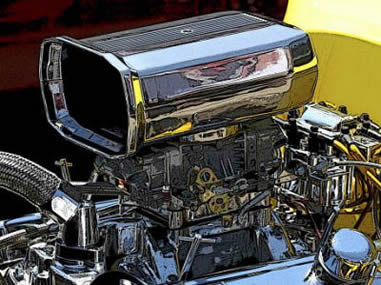 |
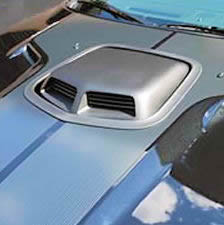 |
|---|---|
Up - Shaker hood scoop, not very effective because not clear of boundary layer |
So, the best air induction kits come with a cold air feed pipe and are fitted in an air box which shields the intake air from the high under bonnet temperatures - the best compromise between the standard air intake box and the induction kit. Some kits have a long pipe which the filter sits at the end nearest the bonnet which really does help cut down the noise and improves the intake temperature.
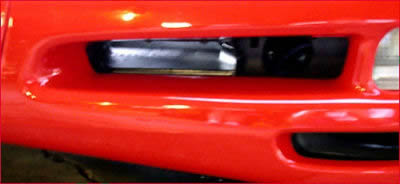
Induction kits that protrude under the front bumper which claim to get more air forced in through the pressure built up on the front of the car as it cuts through air do not have significant power gains, other than the benefit of the cold air from outside the engine bay, - the RAM effect takes speeds up over 150 kmh before a benefit is realized - they are however a great way to collect many botanical specimens of fly's, moths and bugs in the air filter!
NB: Be careful where you site the cold air feed - the last thing you want is to be sucking water into the engine every time you splash through a puddle.
If the induction kits air filter is enclosed in a box with a cold air feed, then more power can be obtained avoiding the hot under bonnet air (Carbon fiber boxes are very good for their heat shielding and durability). It also good to wrap the exhaust manifold with a heat resistant material to keep the under bonnet temperatures down and tasteful vents can be added to the bonnet to take away the heat.
Induction kits sometimes come with a guarantee of "more power". In reality though, the power gains are so small, on small engined cars, they would not be noticeable in real life. Secondly the power increase tends to be at the higher end of the rev range and your low down power band will suffer.
So to summarize, if you have a large engined car (or an engine with good low to mid range torque) fit an induction kit with a cold air feed. If you have a small engined car or one with little power in the lower rev band, fit a direct replacement sports panel air filter.
If you are not racer or your car is purely for moving from point A to B the intake you already have is good enough. Important is that intake leads away from the hot air of the engine, to colder air near the bumper.
Bare in mind that RAM effect is working only after 150km/h
Keep in mind also, you can only increase the airflow so much.
Even if you have no box at all, you have a throttle body that is limiting. An intake manifold that is limiting and intake valves that are limiting.
Put it this way. Imagine a large hallway, with a tiny door at the end.
No matter how big you make the hall way, it doesn't change the door, does it? Only RAM effect can increase the pressure of the intake air, and this is hardly an amateur job.

